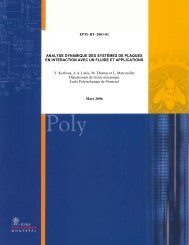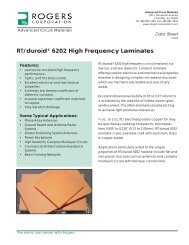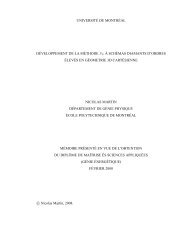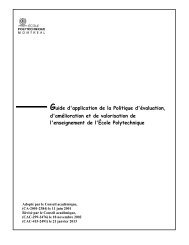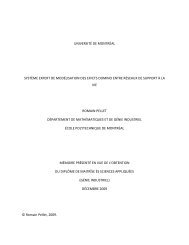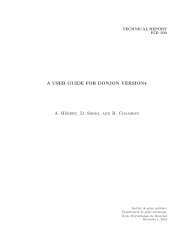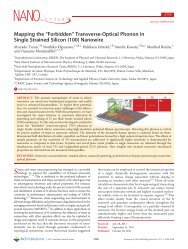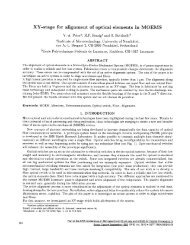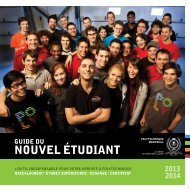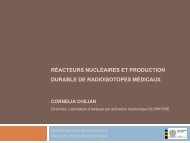MEMS Tunable Silicon Fabry-Perot Cavity - École Polytechnique de ...
MEMS Tunable Silicon Fabry-Perot Cavity - École Polytechnique de ...
MEMS Tunable Silicon Fabry-Perot Cavity - École Polytechnique de ...
You also want an ePaper? Increase the reach of your titles
YUMPU automatically turns print PDFs into web optimized ePapers that Google loves.
<strong>MEMS</strong> <strong>Tunable</strong> <strong>Silicon</strong> <strong>Fabry</strong>-<strong>Perot</strong> <strong>Cavity</strong><br />
Jonathan Masson, Fatou Binetou Koné, Yves-Alain Peter<br />
<strong>École</strong> <strong>Polytechnique</strong> <strong>de</strong> Montréal, Engineering Physics Department<br />
Montréal (Québec) H3C 3A7, CANADA<br />
yves-alain.peter@polymtl.ca<br />
ABSTRACT<br />
In this paper we present an innovative tunable <strong>Fabry</strong>-<strong>Perot</strong> cavity micromachined in silicon. A short summary of the<br />
theoretical background of these filters is presented, followed by technical requirements for the <strong>de</strong>sign of the dielectric<br />
mirror composing the <strong>Fabry</strong>-<strong>Perot</strong> cavity and the cavity itself. Simulations and experimental data are <strong>de</strong>monstrated to be<br />
in good agreement. An in plane <strong>de</strong>sign is used to allow easy fiber alignment. The <strong>Fabry</strong>-<strong>Perot</strong> is tuned by an electrostatic<br />
comb drive actuator supported by a set of four springs to achieve a uniform modulation of the air gap of the filter. Only<br />
15.4 V are required to tune the <strong>Fabry</strong>-<strong>Perot</strong> over 73nm bandwidth (covering more than the whole C-band) with a FWHM<br />
varying from 6 to 10nm. Transmission losses are -11dB.<br />
Keywords: MEMs, grating, <strong>Fabry</strong>-<strong>Perot</strong>, Bragg, DRIE<br />
1. INTRODUCTION<br />
One dimensional silicon photonic crystals are of great interest for several optical applications. They are ma<strong>de</strong> of alternate<br />
layers of air and micro machined silicon. They can be actuated to provi<strong>de</strong> tuning of their optical properties and they are<br />
fabricated by conventional silicon machining processes. Several <strong>de</strong>signs have been proposed but none of them provi<strong>de</strong><br />
fast and wi<strong>de</strong> tuning range, easy fabrication process, low losses and passive fiber alignment 1-4 . In this paper, we report<br />
the fabrication of silicon tunable <strong>Fabry</strong>-<strong>Perot</strong> (FP) resonators ma<strong>de</strong> of two Bragg reflectors as the mirrors of the FP<br />
cavity. Tuning the air gap between the mirrors is ma<strong>de</strong> possible with the use of electrostatic comb drive actuators. High<br />
aspect ratio etching of silicon enables the fabrication of small size features of the filter at the same time as optical fiber<br />
grooves. In plane <strong>de</strong>sign allows an easy way for passive fiber alignment.<br />
Such filters have applications in telecommunication, bio-sensing, and tunable lasers 5 . In fact, fiber lasers can be tuned<br />
over a large bandwidth as Erbium gain, for example, spans over the C and L bands. Inserting a tunable filter insi<strong>de</strong> the<br />
fiber laser cavity makes possible a high power tunable laser suitable for the replacement of many laser sources in<br />
telecommunication systems.<br />
In the next sections, we will fist summarize the basic theory for <strong>de</strong>signing such filters by studying the optical behavior of<br />
Bragg gratings and of <strong>Fabry</strong>-<strong>Perot</strong> cavities. In the second part of the paper, we will <strong>de</strong>tail the fabrication process and<br />
present fabricated <strong>de</strong>vices characterized optically and electrostatically.<br />
2. THEORY<br />
We use the transfer matrix method to simulate the reflected and transmitted light of wavelength λ across the FP filter 6 .<br />
Each layer of silicon and air has its own corresponding characteristic matrix. Let’s first consi<strong>de</strong>r the Bragg reflectors. We<br />
have the following relation between the wavelength and the thickness of each layer:<br />
Nλ<br />
=<br />
4n<br />
Λ , (1)<br />
Optomechatronic Micro/Nano Devices and Components III, edited by Lixin Dong, Yoshitada Katagiri,<br />
Eiji Higurashi, Hiroshi Toshiyoshi, Yves-Alain Peter, Proceedings of SPIE Vol. 6717, 671705, (2007)<br />
0277-786X/07/$18 · doi: 10.1117/12.754325<br />
Proc. of SPIE Vol. 6717 671705-1
with n Si =3.45 and n air =1 at a wavelength λ=1550nm. At the first or<strong>de</strong>r (N=1), we have a silicon thickness of Λ Si =112nm<br />
and an air of Λ air =388nm. However, we can have the dimensions be a multiple of higher or<strong>de</strong>r N=(2m+1)Λ Si , where m is<br />
an integer. We would like the reflectors to be of a wi<strong>de</strong> bandwidth to be used as the mirrors of the FP. A wi<strong>de</strong> reflectance<br />
bandwidth of the Bragg mirrors will provi<strong>de</strong> a wi<strong>de</strong> tuning range for the FP. The transmission peak of the FP filter will<br />
occur within the reflection bandwidth of the mirrors. The or<strong>de</strong>rs of the air and silicon layers are the key elements to<br />
achieve the wi<strong>de</strong> bandwidth objective. Figure 1 shows the relationship between the silicon walls or<strong>de</strong>r and the reflection<br />
peak bandwidth of one Bragg reflector. As the or<strong>de</strong>r of the walls is <strong>de</strong>creased, the reflection peak gets larger. The first<br />
or<strong>de</strong>r is barely visible since it is almost a straight line at the reflectance value of 1.<br />
0<br />
Normalized reflectance<br />
P<br />
- P P P P P P P P<br />
M 0, a 0, 0) 4 0) (0<br />
Fig. 1. Normalized reflectance versus wavelength for a three layer grating with four different or<strong>de</strong>rs: 1 st , 21 st , 51 st<br />
and 101 st .<br />
To make a FP cavity, we use two Bragg reflectors separated by an air gap of thickness<br />
FP<br />
=<br />
mλ<br />
2<br />
Λ ,<br />
where m is the or<strong>de</strong>r of the air gap of the filter. On figure 2, one can see that higher silicon or air or<strong>de</strong>r improves the<br />
finesse of the filter, but <strong>de</strong>creases the stopband, thus limiting the tuning range. A filter with an or<strong>de</strong>r around 23 rd , seems<br />
to be a good compromise between tuning range, finesse, and the size of the walls for ease of fabrication. The number of<br />
walls of the Bragg reflectors has an impact on the reflectivity of the Bragg reflector: the higher the number of walls, the<br />
higher the reflection and thus a better finesse of the FP cavity. But in practice, since the fabrication process generates<br />
<strong>de</strong>viations on the geometry of the walls, increasing the number of walls will also increase the losses. In fact, the walls are<br />
not perfectly vertical due to the <strong>de</strong>ep etching process. Adding more walls will increase losses since light experience<br />
multiple reflections on each layer of the grating. We found experimentally that the optimal number of walls is three.<br />
Proc. of SPIE Vol. 6717 671705-2
0.9<br />
0.7<br />
=<br />
a)<br />
C-,<br />
0.6<br />
E<br />
C,)<br />
=<br />
0.5<br />
0<br />
a)<br />
N<br />
0.4<br />
E<br />
0<br />
z 0.3<br />
0.2<br />
10500 1510 1520 1530 1540 1550 1560 1570 1580 1590 1600<br />
Wavelength (nm)<br />
Fig. 2. Normalized transmittance versus wavelength of a <strong>Fabry</strong>-<strong>Perot</strong> cavity with two three-layers gratings as reflectors and<br />
a gap of λ (m=2). Inset: close up view of the peaks for three different or<strong>de</strong>rs of the gratings: 1 st , 23 rd and 41 st .<br />
3. FABRICATION<br />
The <strong>de</strong>vices are fabricated by silicon micromachining. We fabricate the <strong>Fabry</strong> <strong>Perot</strong> and the optical fiber grooves in one<br />
single step of <strong>de</strong>ep reactive ion etching (DRIE) on a 70µm thick silicon on insulator (SOI) wafer. The process flow is<br />
shown on figure 3. (a) We start with 70µm thick <strong>de</strong>vice layer silicon on insulator (SOI) wafer. (b) A 4 µm thick layer of<br />
SPR220 3.0 photoresist is spinned. A thick masking layer is nee<strong>de</strong>d for the 70µm DRIE step. Figure 3. (c) shows the<br />
inductive coupled plasma (ICP) DRIE step. Verticality of the etched structures is of prime importance in or<strong>de</strong>r to lower<br />
the optical losses of the <strong>de</strong>vices. Therefore, we use a 450W forward ICP power, and 25W and 10W RF power for the<br />
etch step and the passivation step respectively. The etching process is ma<strong>de</strong> at a pressure of 15mTorr. The pressure is an<br />
important factor in the si<strong>de</strong>wall profile control. Smoothness of the walls can be improved by adding oxygen during the<br />
etch step. (d) The 2µm buried oxi<strong>de</strong> layer is etched away in liquid HF to release the structures and supercritical CO 2<br />
drying is used to prevent the <strong>de</strong>vices from sticking. Two optical fibers can be placed on each si<strong>de</strong> of the FP cavity. They<br />
are passively aligned by the <strong>de</strong>ep silicon square grooves. We use 125 µm diameter single mo<strong>de</strong> fibers (Corning SMF-<br />
28e) so the top of the fiber core is 5.4µm lower than the top of the grating to insure a good coupling with the grating.<br />
Figure 4 is a scanning electron micrograph of a fabricated <strong>de</strong>vice. The FP cavity is formed by two Bragg reflectors each<br />
of them ma<strong>de</strong> of three silicon walls (see inset of Fig. 4). One of the Bragg reflectors can be actuated with an electrostatic<br />
comb drive suspen<strong>de</strong>d by a set of four springs to provi<strong>de</strong> a uniform modulation of the air gap. Applying a voltage<br />
difference between the two electro<strong>de</strong>s will make the combs move closer to each other reducing the air gap of the FP<br />
filter. As mentioned in the previous section, reducing the air gap reduces the filtered wavelength.<br />
The vertical roughness of one silicon wall of a Bragg mirror was measured with an AFM, and is 26.2nm rms. Verticality<br />
was estimated on a scanning electron micrograph to be less than 0.5°.<br />
Proc. of SPIE Vol. 6717 671705-3
c)<br />
<strong>Tunable</strong><br />
Bragg<br />
mirror<br />
II 1111<br />
d)<br />
Fig. 3. Microfabrication steps for the tunable FP. (a) A 70µm thick <strong>de</strong>vice layer SOI is used. (b) Photolithography of 4µm thick resist<br />
layer. (c) Vertical etching of the 70µm <strong>de</strong>vice layer by DRIE. (d) The structures are released by etching silicon oxi<strong>de</strong> in liquid HF.<br />
Fig. 4. SEM photograph of one silicon microfabricated <strong>Fabry</strong>-<strong>Perot</strong> <strong>de</strong>vice. The inset is a zoom on the two Bragg mirrors composing<br />
the FP cavity.<br />
Proc. of SPIE Vol. 6717 671705-4
4. RESULTS<br />
In this section we will first report the behavior of the Bragg grating used as one mirror of the FP. Then we will present<br />
the FP itself. Finally we will <strong>de</strong>monstrate the effect of tuning the air gap of the silicon FP cavity.<br />
4.1 Bragg gratings<br />
We experimentally observed the reflection bandwidth <strong>de</strong>creasing while increasing the or<strong>de</strong>r of silicon layers as predicted<br />
in the previous section. Figure 5 shows three different experimental reflection spectra for 21 st , 41 st and 101 st or<strong>de</strong>r of<br />
silicon. We can clearly see that the number of reflection peak increases with higher or<strong>de</strong>rs.<br />
Reflectivity [dB]<br />
0<br />
-2<br />
-4<br />
-6<br />
-8<br />
-10<br />
-12<br />
-14<br />
-16<br />
21st or<strong>de</strong>r<br />
-18<br />
41st or<strong>de</strong>r<br />
101st or<strong>de</strong>r<br />
-20<br />
1500 1520 1540 1560 1580 1600<br />
Wavelength [nm]<br />
Fig. 5. Experimental spectra of three <strong>de</strong>vices having 21 st , 41 st and 101 st or<strong>de</strong>r of silicon<br />
Figure 6 shows the reflection spectra of one fabricated Bragg reflector and of the corresponding simulation. The overall<br />
spectral behaviors are very similar. Since reflection losses were not consi<strong>de</strong>red in the simulations, the experimental data<br />
present higher reflection losses compared to simulations. The reflection losses are mainly due to verticality <strong>de</strong>viations of<br />
the walls and due to scattering. Other imperfections are introduced by the fabrication process. In particular, the silicon<br />
walls are thinner than expected because of the DRIE step. The real dimensions of the grating differ from the i<strong>de</strong>al ones<br />
computed by equation 1 and therefore the real spectra differ from the i<strong>de</strong>al ones shown in figure 1. A <strong>de</strong>viation on the<br />
wall thickness generates a larger bandwidth and causes the reflection and transmission peaks to shift wavelength.<br />
Proc. of SPIE Vol. 6717 671705-5
0<br />
-5<br />
Reflectivity [dB]<br />
-10<br />
-15<br />
-20<br />
Experimental data<br />
Simulation<br />
-25<br />
1500 1510 1520 1530 1540 1550 1560 1570 1580 1590 1600<br />
Wavelength [nm]<br />
Fig. 6. Simulated (plain line) and measured (doted line) reflectivity for a Bragg grating with a 41 st silicon or<strong>de</strong>r, 11 th air or<strong>de</strong>r and<br />
three silicon walls.<br />
4.2 <strong>Fabry</strong>-<strong>Perot</strong><br />
First, we will consi<strong>de</strong>r fixed FP filters. The transmission spectrum has a typical band-pass behavior for a FP filter (Fig.<br />
7). The transmission loss is -11dB witch is comparable to previously reported silicon filter 2-3 and the isolation is -20dB.<br />
The bandwidth at -3dB is 14 nm.<br />
-12<br />
Transmission [dB]<br />
-17<br />
-22<br />
-27<br />
-32<br />
1500 1520 1540 1560 1580 1600<br />
Wavelength [nm]<br />
Fig. 7. Experimental transmission spectrum of a fabricated silicon FP cavity.<br />
Proc. of SPIE Vol. 6717 671705-6
In a second step, we fabricate tunable FP cavities that are actuated using electrostatic comb drive suspen<strong>de</strong>d by four<br />
springs (Fig. 8). The comb drive allows a uniform displacement of the grating by applying a low voltage difference<br />
between the combs. The uniform modulation of this air gap is of a prime importance and represents a significant<br />
improvement compared to Lipson 2 . In<strong>de</strong>ed, a non-uniform modulation would generate an angle between the two Bragg<br />
reflectors changing the resonance properties of the FP. These changes could be expressed by a different filtered<br />
wavelength, limited tuning range or by increasing significantly transmission losses. Figure 9 shows the effect on the<br />
spectra of the air gap tuning of a FP cavity. The initial transmission peak is 1592nm. As voltage is increased, the air gap<br />
between the two Bragg reflectors is <strong>de</strong>creased. Thus, the transmission peak shifts towards smaller wavelengths. The filter<br />
can be tuned continuously down to 1519nm for a total tuning range of 73nm. The FWHM varies from 6 to 10nm. The<br />
maximum applied voltage (maximum tuning range of the cavity) is 15.4V.<br />
Movable comb<br />
\<br />
<strong>Fabry</strong>-<strong>Perot</strong><br />
cavibj J<br />
IIIIIIIIIIIIIIIIIIIIIIIIIIIØftttlfIIIIIIIIIIII,$IIIIIIIIIIIIIIIIIIIII<br />
Fixed comb<br />
Anchors<br />
Fig. 8. Schematic of the <strong>de</strong>vice including the comb drive actuator and the four springs mechanism.<br />
-9<br />
15.4 V<br />
14.7 V<br />
-11<br />
14.0 V<br />
-13<br />
Transmission (dB)<br />
-15<br />
-17<br />
-19<br />
13.2 V<br />
12.4 V<br />
11.2 V<br />
9.1 V<br />
0 V<br />
-21<br />
-23<br />
-25<br />
1500 1520 1540 1560 1580 1600<br />
Wavelength (nm)<br />
Fig. 9. Transmission spectra of the FP filter tuned from 1592nm down to 1519nm. The voltage applied to the comb drive actuator goes<br />
from 0V to 15.4V.<br />
Proc. of SPIE Vol. 6717 671705-7
We characterized the modulation of the air gap of the FP filter versus the applied voltage (Fig. 10). The measurements<br />
were ma<strong>de</strong> by a dynamic white light interferometer. One can see that the maximum tuned wavelength is reached when<br />
the air gap is reduced of about 850nm, corresponding to the maximum applied voltage of 15.4V.<br />
1800<br />
1600<br />
1400<br />
Displacement [nm]<br />
1200<br />
1000<br />
800<br />
600<br />
400<br />
200<br />
0<br />
0 5 10 15 20<br />
Voltage [V]<br />
Fig. 10. Measured displacement of the one Bragg mirror versus applied voltage.<br />
5. CONCLUSION<br />
The <strong>de</strong>sign of a continuous tunable <strong>Fabry</strong>-<strong>Perot</strong> micro machined in silicon is presented. We <strong>de</strong>monstrate a novel highly<br />
tunable FP filter in silicon that is fabricated in one single etch step. Our process allows good wall roughness of 26.2nm<br />
rms and high verticality of less than 0.5°. Moreover, the modulation of the air gap is ma<strong>de</strong> uniform using a comb drive<br />
and a set of four springs. Measured optical characteristics are in good agreement with the predicted ones from the<br />
numerical simulations. We <strong>de</strong>monstrated theoretically and experimentally the influence of the or<strong>de</strong>r of the silicon/air<br />
pair. The tuning effect of the FP air gap is reported on a bandwidth as large as 73nm covering more than the whole C-<br />
band. The transmission losses are -11dB. The maximum actuation voltage required to cover the whole tuning bandwidth<br />
is 15.4 V.<br />
6. REFERENCES<br />
1<br />
2<br />
3<br />
S.-S. Yun, K.-W. Jo, J.-H. Lee, "Crystalline Si-based in-plane tunable <strong>Fabry</strong>-<strong>Perot</strong> filter with wi<strong>de</strong> tunable range," in<br />
IEEE/LEOS International Conference on Optical <strong>MEMS</strong> and Their Applications, pp 77-78, 2003.<br />
A. Lipson, E. M. Yeatman, "Free-space <strong>MEMS</strong> tunable optical filter on (110) silicon", in International Conference<br />
on Optical <strong>MEMS</strong> and Their Applications, Oulu, Finalnd, 2005, pp. 73-74, IEEE/LEOS.<br />
B. Saadany, M. Malak, F. Marty, Y. Mita, D. Khalil, and T. Bourouina, "Electrostatically-tuned Optical Filter Based<br />
on <strong>Silicon</strong> Bragg Reflectors", in IEEE/LEOS International Conference on Optical <strong>MEMS</strong> and Their Applications,<br />
Big Sky, Montana, 2006, pp. 86-87.<br />
Proc. of SPIE Vol. 6717 671705-8
4<br />
5<br />
6<br />
M. W. Pruessner, T. H. Stievater, and W. S. Rabinovich, "Integrated wavegui<strong>de</strong> <strong>Fabry</strong>–<strong>Perot</strong> microcavities with<br />
silicon/air Bragg mirrors", Optics Letters, Vol. 32, No. 5, 2007.<br />
J. Masson, S. Bergeron, A. Poulin, N. Godbout and Y.-A. Peter, "<strong>Tunable</strong> erbium doped fiber laser using a silicon<br />
micro-electro-mechanical (MEM) <strong>Fabry</strong>-<strong>Perot</strong> cavity", accepted in IEEE/LEOS International Conference on Optical<br />
<strong>MEMS</strong> and Nanophotonics, Hualien, Taiwan, August 2007.<br />
Y.-A. Peter, F. B. Koné, J. Masson and N. Godbout, "<strong>Tunable</strong> micro-electromechanical grating in silicon," (invited<br />
paper) in SPIE Optomechatronic Micro/Nano Devices and Components II, Optics East 2006, Boston, Massachusetts,<br />
vol. 6376, paper 04, SPIE.<br />
Proc. of SPIE Vol. 6717 671705-9


